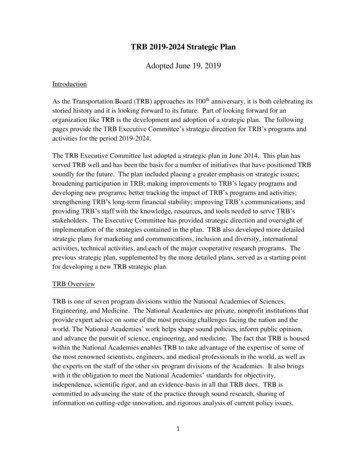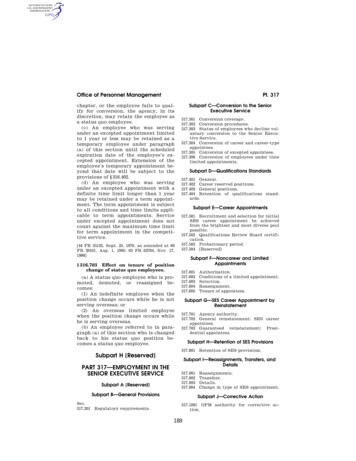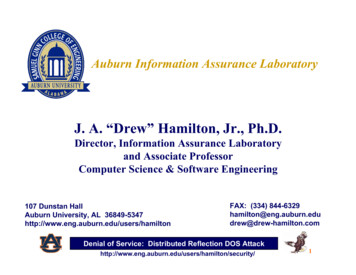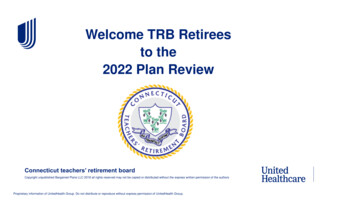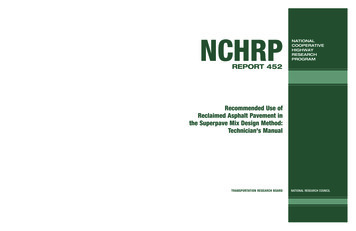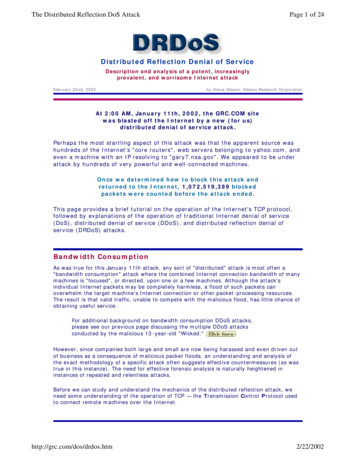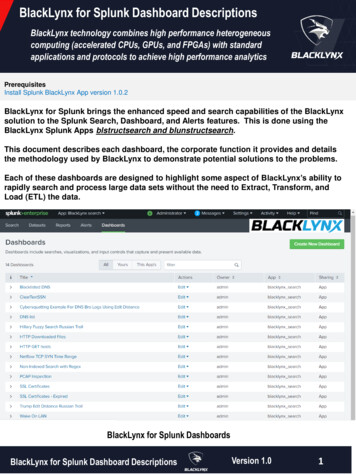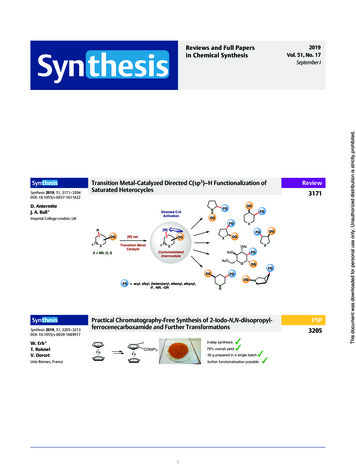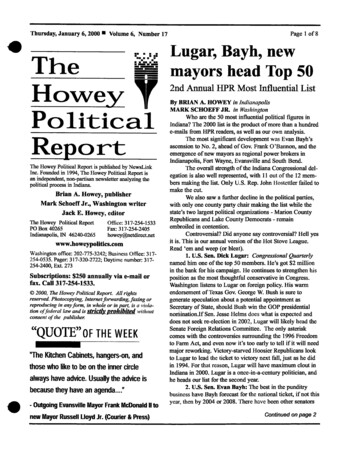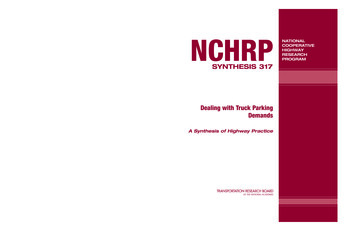
Transcription
20146 TRB NCHRP Syn 317 cvrPMS 202TRANSPORTATION RESEARCH BOARD500 Fifth Street, N.W.Washington, D.C. 20001ADDRESS SERVICE REQUESTEDNCHRPSYNTHESIS 317Dealing with Truck ParkingDemandsA Synthesis of Highway PracticeNATIONALCOOPERATIVEHIGHWAYRESEARCHPROGRAM
TRANSPORTATION RESEARCH BOARD EXECUTIVE COMMITTEE 2003 (Membership as of March 2003)OfficersChair: GENEVIEVE GIULIANO, Director and Professor, School of Policy, Planning, and Development, University of Southern California, Los AngelesVice Chairman: MICHAEL S. TOWNES, Executive Director, Transportation District Commission of Hampton Roads, Hampton, VAExecutive Director: ROBERT E. SKINNER, JR., Transportation Research BoardMembersMICHAEL W. BEHRENS, Executive Director, Texas Department of TransportationJOSEPH H. BOARDMAN, Commissioner, New York State DOTSARAH C. CAMPBELL, President, TransManagement, Inc., Washington, D.C.E. DEAN CARLSON, Secretary of Transportation, Kansas DOTJOANNE F. CASEY, President, Intermodal Association of North America, Greenbelt, MDJAMES C. CODELL III, Secretary, Kentucky Transportation CabinetJOHN L. CRAIG, Director, Nebraska Department of RoadsBERNARD S. GROSECLOSE, JR., President and CEO, South Carolina State Ports AuthoritySUSAN HANSON, Landry University Professor of Geography, Clark UniversityLESTER A. HOEL, L.A. Lacy Distinguished Professor, Department of Civil Engineering, University of VirginiaHENRY L. HUNGERBEELER, Director, Missouri DOTADIB K. KANAFANI, Cahill Professor and Chairman, Department of Civil and Environmental Engineering, University of California at BerkeleyRONALD F. KIRBY, Director-Transportation Planning, Metropolitan Washington Council of GovernmentsHERBERT S. LEVINSON, Principal, Herbert S. Levinson Transportation Consultant, New Haven, CTMICHAEL D. MEYER, Professor, School of Civil and Environmental Engineering, Georgia Institute of TechnologyJEFF P. MORALES, Director of Transportation, California DOTKAM MOVASSAGHI, Secretary of Transportation, Louisiana Department of Transportation and DevelopmentCAROL A. MURRAY, Commissioner, New Hampshire DOTDAVID PLAVIN, President, Airports Council International, Washington, D.C.JOHN REBENSDORF, Vice President, Network and Service Planning, Union Pacific Railroad CompanyCATHERINE L. ROSS, Executive Director, Georgia Regional Transportation AgencyJOHN M. SAMUELS, Senior Vice President, Operations, Planning, & Support, Norfolk Southern CorporationPAUL P. SKOUTELAS, CEO, Port Authority of Allegheny County, Pittsburgh, PAMARTIN WACHS, Director, Institute of Transportation Studies, University of California at BerkeleyMICHAEL W. WICKHAM, Chairman and CEO, Roadway Express, Inc., Akron, OHMIKE ACOTT, President, National Asphalt Pavement Association (ex officio)MARION C. BLAKEY, Federal Aviation Administration, U.S. DOT (ex officio)REBECCA M. BREWSTER, President and CEO, American Transportation Research Institute (ex officio)THOMAS H. COLLINS, (Adm., U.S. Coast Guard) Commandant, U.S. Coast Guard (ex officio)JENNIFER L. DORN, Federal Transit Administrator, U.S. DOT (ex officio)ELLEN G. ENGLEMAN, Research and Special Programs Administrator, U.S. DOT (ex officio)ROBERT B. FLOWERS (Lt. Gen., U.S. Army), Chief of Engineers and Commander, U.S. Army Corps of Engineers (ex officio)HAROLD K. FORSEN, Foreign Secretary, National Academy of Engineering (ex officio)EDWARD R. HAMBERGER, President and CEO, Association of American Railroads (ex officio)JOHN C. HORSLEY, Executive Director, American Association of State Highway and Transportation Officials (ex officio)MICHAEL P. JACKSON, Deputy Secretary of Transportation, U.S. DOT (ex officio)ROGER L. KING, Chief Applications Technologist, National Aeronautics and Space Administration (ex officio)ROBERT S. KIRK, Director, Office of Advanced Automotive Technologies, U.S. Department of Energy (ex officio)RICK KOWALEWSKI, Acting Director, Bureau of Transportation Statistics, U.S. DOT (ex officio)WILLIAM W. MILLAR, President, American Public Transit Association (ex officio)MARY E. PETERS, Federal Highway Administrator, U.S. DOT (ex officio)SUZANNE RUDZINSKI, Director, Office of Transportation and Air Quality, U.S. Environmental Protection Agency (ex officio)JEFFREY W. RUNGE, National Highway Traffic Safety Administrator, U.S. DOT (ex officio)ALLAN RUTTER, Federal Railroad Administrator, U.S. DOT (ex officio)ANNETTE M. SANDBERG, Deputy Administrator, Federal Motor Carrier Safety Administration, U.S. DOT (ex officio)WILLIAM G. SCHUBERT (Captain), Administrator, Maritime Administration, U.S. DOT (ex officio)NATIONAL COOPERATIVE HIGHWAY RESEARCH PROGRAMTransportation Research Board Executive Committee Subcommittee for NCHRPGENEVIEVE GIULIANO, University of Southern California, Los Angeles(Chair)E. DEAN CARLSON, Kansas DOTLESTER A. HOEL, University of VirginiaJOHN C. HORSLEY, American Association of State Highway andTransportation OfficialsMARY E. PETERS, Federal Highway AdministrationROBERT E. SKINNER, JR., Transportation Research BoardMICHAEL S. TOWNES, Transportation District Commission of Hampton RoadsField of Special ProjectsProject Committee SP 20-5Program StaffGARY D. TAYLOR, CTE Engineers (Chair)SUSAN BINDER, Federal Highway AdministrationTHOMAS R. BOHUSLAV, Texas DOTDONN E. HANCHER, University of KentuckyDWIGHT HORNE, Federal Highway AdministrationYSELA LLORT, Florida DOTWESLEY S.C. LUM, California DOTJOHN M. MASON, JR., Pennsylvania State UniversityLARRY VALESQUEZ, New Mexico SHTDPAUL T. WELLS, New York State DOTJ. RICHARD YOUNG, JR., Post Buckley Schuh & Jernigan, Inc.MARK R. NORMAN, Transportation Research Board (Liaison)WILLIAM ZACCAGNINO, Federal Highway Administration (Liaison)ROBERT J. REILLY, Director, Cooperative Research ProgramsCRAWFORD F. JENCKS, Manager, NCHRPDAVID B. BEAL, Senior Program OfficerHARVEY BERLIN, Senior Program OfficerB. RAY DERR, Senior Program OfficerAMIR N. HANNA, Senior Program OfficerEDWARD T. HARRIGAN, Senior Program OfficerCHRISTOPHER HEDGES, Senior Program OfficerTIMOTHY G. HESS, Senior Program OfficerRONALD D. MCCREADY, Senior Program OfficerCHARLES W. NIESSNER, Senior Program OfficerEILEEN P. DELANEY, Managing EditorHILARY FREER, Associate EditorTRB Staff for NCHRP Project 20-5STEPHEN R. GODWIN, Director for Studies and Information ServicesDONNA L. VLASAK, Senior Program OfficerDON TIPPMAN, EditorJON WILLIAMS, Manager, Synthesis StudiesCHERYL Y. KEITH, Senior Secretary
NATIONAL COOPERATIVE HIGHWAY RESEARCH PROGRAMNCHRPSYNTHESIS 317Dealing with Truck Parking DemandsA Synthesis of Highway PracticeCONSULTANTDR. JEFFREY W. TROMBLYOak Ridge, TennesseeTOPIC PANELCHARLIE CARDEN, North Carolina Department of Motor Vehicle EnforcementRALPH L. CARHART, California Department of TransportationROBERT DAVIS, Federal Highway AdministrationJENNIFER HOPKINS BISHOP, National Transportation Safety BoardELAINE KING, Transportation Research BoardRAYMOND A. KRAMMES, Federal Highway AdministrationDEAN PERKINS, Florida Department of TransportationCAROL J. REAMER, Minnesota Department of TransportationELAINE RICCIO, Federal Motor Carrier Safety AdministrationNORMAN R. SCHNEIDER, New York State Department of TransportationWAYNE TETEN, Nebraska Department of RoadsFRED WEGMAN, University of TennesseeSUBJECT AREASOperations and Safety and Freight TransportationResearch Sponsored by the American Association of State Highway and Transportation Officialsin Cooperation with the Federal Highway AdministrationTRANSPORTATION RESEARCH BOARDWASHINGTON, D.C.2003www.TRB.org
NATIONAL COOPERATIVE HIGHWAY RESEARCHPROGRAMSystematic, well-designed research provides the most effectiveapproach to the solution of many problems facing highway administrators and engineers. Often, highway problems are of localinterest and can best be studied by highway departments individually or in cooperation with their state universities and others. However, the accelerating growth of highway transportation developsincreasingly complex problems of wide interest to highway authorities. These problems are best studied through a coordinatedprogram of cooperative research.In recognition of these needs, the highway administrators ofthe American Association of State Highway and TransportationOfficials initiated in 1962 an objective national highway researchprogram employing modern scientific techniques. This programis supported on a continuing basis by funds from participatingmember states of the Association and it receives the full cooperation and support of the Federal Highway Administration, UnitedStates Department of Transportation.The Transportation Research Board of the National ResearchCouncil was requested by the Association to administer the research program because of the Board’s recognized objectivity andunderstanding of modern research practices. The Board isuniquely suited for this purpose as it maintains an extensivecommittee structure from which authorities on any highwaytransportation subject may be drawn; it possesses avenues ofcommunication and cooperation with federal, state, and localgovernmental agencies, universities, and industry; its relationshipto the National Research Council is an insurance of objectivity; itmaintains a full-time research correlation staff of specialists inhighway transportation matters to bring the findings of researchdirectly to those who are in a position to use them.The program is developed on the basis of research needs identified by chief administrators of the highway and transportationdepartments and by committees of AASHTO. Each year, specificareas of research needs to be included in the program are proposedto the National Research Council and the Board by the AmericanAssociation of State Highway and Transportation Officials. Research projects to fulfill these needs are defined by the Board, andqualified research agencies are selected from those that havesubmitted proposals. Administration and surveillance of researchcontracts are the responsibilities of the National Research Counciland the Transportation Research Board.The needs for highway research are many, and the NationalCooperative Highway Research Program can make significantcontributions to the solution of highway transportation problemsof mutual concern to many responsible groups. The program,however, is intended to complement rather than to substitute foror duplicate other highway research programs.NCHRP SYNTHESIS 317Project 20-5 FY 2002 (Topic 32-01)ISSN 0547-5570ISBN 0-309-06963-7Library of Congress Control No. 2003106783 2003 Transportation Research BoardPrice 14.00NOTICEThe project that is the subject of this report was a part of the National Cooperative Highway Research Program conducted by the Transportation Research Board with the approval of the Governing Board of the National Research Council. Such approval reflects the Governing Board’s judgment that the program concerned is of national importance and appropriatewith respect to both the purposes and resources of the National ResearchCouncil.The members of the technical committee selected to monitor this project and to review this report were chosen for recognized scholarly competence and with due consideration for the balance of disciplines appropriate to the project. The opinions and conclusions expressed or impliedare those of the research agency that performed the research, and, whilethey have been accepted as appropriate by the technical committee, theyare not necessarily those of the Transportation Research Board, the National Research Council, the American Association of State Highway andTransportation Officials, or the Federal Highway Administration of the U.S.Department of Transportation.Each report is reviewed and accepted for publication by the technicalcommittee according to procedures established and monitored by theTransportation Research Board Executive Committee and the GoverningBoard of the National Research Council.Published reports of theNATIONAL COOPERATIVE HIGHWAY RESEARCH PROGRAMare available from:NOTE: The Transportation Research Board of the National Academies, the National Research Council, the Federal Highway Administration, the American Association of State Highway and Transportation Officials, and the individual states participating in the NationalCooperative Highway Research Program do not endorse products ormanufacturers. Trade or manufacturers’ names appear hereinsolely because they are considered essential to the object of thisreport.Transportation Research BoardBusiness Office500 Fifth StreetWashington, D.C. 20001and can be ordered through the Internet Printed in the United States of America
THE NATIONAL ACADEMIESAdvisers to the Nation on Science, Engineering, and MedicineThe National Academy of Sciences is a private, nonprofit, self-perpetuating society of distinguished scholarsengaged in scientific and engineering research, dedicated to the furtherance of science and technology andto their use for the general welfare. On the authority of the charter granted to it by the Congress in 1863, theAcademy has a mandate that requires it to advise the federal government on scientific and technical matters.Dr. Bruce M. Alberts is president of the National Academy of Sciences.The National Academy of Engineering was established in 1964, under the charter of the NationalAcademy of Sciences, as a parallel organization of outstanding engineers. It is autonomous in itsadministration and in the selection of its members, sharing with the National Academy of Sciences theresponsibility for advising the federal government. The National Academy of Engineering also sponsorsengineering programs aimed at meeting national needs, encourages education and research, and recognizes thesuperior achievements of engineers. Dr. William A. Wulf is president of the National Academy ofEngineering.The Institute of Medicine was established in 1970 by the National Academy of Sciences to secure theservices of eminent members of appropriate professions in the examination of policy matters pertaining tothe health of the public. The Institute acts under the responsibility given to the National Academy ofSciences by its congressional charter to be an adviser to the federal government and, on its owninitiative, to identify issues of medical care, research, and education. Dr. Harvey V. Fineberg is presidentof the Institute of Medicine.The National Research Council was organized by the National Academy of Sciences in 1916 to associatethe broad community of science and technology with the Academy’s purposes of furthering knowledge andadvising the federal government. Functioning in accordance with general policies determined by the Academy, the Council has become the principal operating agency of both the National Academy of Sciences andthe National Academy of Engineering in providing services to the government, the public, and the scientificand engineering communities. The Council is administered jointly by both Academies and the Institute ofMedicine. Dr. Bruce M. Alberts and Dr. William A. Wulf are chair and vice chair, respectively, of theNational Research Council.The Transportation Research Board is a division of the National Research Council, which serves theNational Academy of Sciences and the National Academy of Engineering. The Board’s mission is to promoteinnovation and progress in transportation by stimulating and conducting research, facilitating thedissemination of information, and encouraging the implementation of research results. The Board’s variedactivities annually engage more than 4,000 engineers, scientists, and other transportation researchers andpractitioners from the public and private sectors and academia, all of whom contribute their expertise in thepublic interest. The program is supported by state transportation departments, federal agencies includingthe component administrations of the U.S. Department of Transportation, and other organizations andindividuals interested in the development of transportation. www.TRB.orgwww.national-academies.org
FOREWORDBy StaffTransportationResearch BoardPREFACEHighway administrators, engineers, and researchers often face problems for which information already exists, either in documented form or as undocumented experience andpractice. This information may be fragmented, scattered, and unevaluated. As a consequence, full knowledge of what has been learned about a problem may not be brought tobear on its solution. Costly research findings may go unused, valuable experience may beoverlooked, and due consideration may not be given to recommended practices for solving or alleviating the problem.There is information on nearly every subject of concern to highway administrators andengineers. Much of it derives from research or from the work of practitioners faced withproblems in their day-to-day work. To provide a systematic means for assembling andevaluating such useful information and to make it available to the entire highway community, the American Association of State Highway and Transportation Officials—through the mechanism of the National Cooperative Highway Research Program—authorized the Transportation Research Board to undertake a continuing study. Thisstudy, NCHRP Project 20-5, “Synthesis of Information Related to Highway Problems,”searches out and synthesizes useful knowledge from all available sources and preparesconcise, documented reports on specific topics. Reports from this endeavor constitute anNCHRP report series, Synthesis of Highway Practice.The synthesis series reports on current knowledge and practice, in a compact format,without the detailed directions usually found in handbooks or design manuals. Each report in the series provides a compendium of the best knowledge available on those measures found to be the most successful in resolving specific problems.This report of the Transportation Research Board is designed to assist transportationagency administrators in identifying those practices that have been used to manage theincreasing demand for truck parking. The emphasis is on identifying successful and innovative strategies that have been implemented by transportation agencies, as well as potential strategies yet to be deployed. The report examines the legislative authority governingthe provision of truck parking by state transportation agencies, including federal requirements and selected state laws, to provide a framework for action. An analysis is providedof the demand for truck parking. Several case studies are discussed.Information for this report was derived primarily from a detailed survey questionnairethat was distributed to highway maintenance engineers in all 50 states, the District of Columbia, and Puerto Rico. Responses were received from 24 transportation agencies. In severalinstances, the maintenance engineers supplemented their survey responses with additionaldocumentation, including reports on the nature and magnitude of the truck parking problem,as well as master plans for documenting state strategies designed to address parking deficiencies. A literature review was also undertaken. The amount of literature on this subjectis not extensive, but is adequate enough to provide the necessary background on the topicand reinforce conclusions drawn from the survey responses and interviews.A panel of experts in the subject area guided the work of organizing and evaluating thecollected data and reviewed the final synthesis report. A consultant was engaged tocollect and synthesize the information and to write this report. Both the consultant andthe members of the oversight panel are acknowledged on the title page. This synthesis isan immediately useful document that records the practices that were acceptable within thelimitations of the knowledge available at the time of its preparation. As progress in research and practice continues, new knowledge will be added to that now at hand.
CONTENTS1SUMMARY3CHAPTER ONEINTRODUCTIONPurpose, 3Background, 3Section 4027 Study, 4Purpose and Scope, 5Methodology, 5Organization, 56CHAPTER TWOLEGISLATIVE AUTHORITYPurpose, 6Historical Perspective, 6Commercial Vehicle Parking Limits, 6Limits to Commercialization of Rest Areas, 7Rest Area Funding, 7Rest Area Master Planning, 7State Legislative, Legal, and Regulatory Authority to Support Planning,Constructing, Maintaining, and Operating Rest Areas, 8Summary, 89CHAPTER THREEEXTENT OF THE PROBLEMIntroduction, 9Factors Influencing Parking Demand, 9Parking Demand: National Commercial Vehicles, 9Parking Supply: Public Rest Areas, 10Parking Supply: Commercial Truck Stop and Travel Plazas, 10Analysis of Supply and Demand, 10Survey Results, 14Summary, 1415CHAPTER FOURSTATE PRACTICES AND POTENTIAL SOLUTIONSSurvey Results, 15Summary of Section 4027 Study Strategies, 17Expand Public Facilities, 17Case Study: New York State, 17Expand or Improve Commercial Truck Stops and Travel Plazas, 18Encourage Information of Public–Private Relationships, 18Case Study: California, 18Better Educate or Inform Drivers About Available Spaces, 19Case Study: Maryland, 20Parking Enforcement Rules, 20Case Study: Kentucky Transportation Cabinet, 20Case Study: Minnesota, 20Summary, 20
21CHAPTER FIVE23REFERENCES24APPENDIX ASURVEY QUESTIONNAIRE30APPENDIX BLIST OF SURVEY RESPONDENTS31APPENDIX CTABLES OF SURVEY RESPONSESCONCLUSIONSACKNOWLEDGMENTSDr. Jeffrey W. Trombly, Oak Ridge, Tennessee, was responsiblefor collection of the data and preparation of the report.Valuable assistance in the preparation of this synthesis was provided by the Topic Panel, consisting of Major Charlie Carden, Assistant Law Enforcement Director, Field Operations, North CarolinaDepartment of Motor Vehicle Enforcement; Ralph L. Carhart, Roadside Rest Area Coordinator, Office of Administration; Jennifer Hopkins Bishop, Project Manager, Office of Highway Safety, NationalTransportation Safety Board; Elaine King, Senior Program Officer,Technical Activities, Transportation Research Board; Raymond A.Krammes, Turner–Fairbank Highway Research Center, FederalHighway Administration; Dean Perkins, Structures Office, FloridaDepartment of Transportation; Carol J. Reamer, R.L.A., Site Development Unit Manager, Office of Technical Support, Minnesota Department of Transportation; Elaine Riccio, Transportation Specialist,Federal Motor Carrier Safety Administration; Norman R. Schneider,Director, Freight and Economic Development Division, New YorkState Department of Transportation; Wayne Teten, Deputy State Engineer, Nebraska Department of Roads; and Fred Wegman, Professor,Department of Civil Engineering, University of Tennessee.This study was managed by Stephen F. Maher, P.E., and JonWilliams, Managers, Synthesis Studies, who worked with theconsultant, the Topic Panel, and the Project 20-5 Committee in thedevelopment and review of the report. Assistance in project scopedevelopment was provided by Donna Vlasak, Senior ProgramOfficer. Don Tippman was responsible for editing and production.Cheryl Keith assisted in meeting logistics and distribution of thequestionnaire and draft reports.Crawford F. Jencks, Manager, National Cooperative Highway Research Program, assisted the NCHRP 20-5 Committee and the Synthesis staff.Information on current practice was provided by many highwayand transportation agencies. Their cooperation and assistance areappreciated.
DEALING WITH TRUCK PARKING DEMANDSSUMMARYIt is nationally recognized that commercial motor vehicle operators frequently cannot findadequate, safe parking for rest purposes. Many state departments of transportation are experiencing a heavy demand for commercial vehicle parking at rest areas, one that exceedscapacity. These rest areas are intended for short-term safety breaks; however, there continuesto be a need for longer-term parking services in high-use corridors. Private truck stops oftenprovide facilities that allow drivers to use them for longer-term stays to obtain adequate rest.For many of these private truck stops, demand also exceeds capacity. The purpose of thissynthesis is to assist transportation agency administrators in identifying those practices thathave been used to manage the increasing demand for commercial motor vehicle parking.The emphasis is on identifying successful and innovative strategies that have been implemented by transportation agencies as well as potential strategies that have yet to be deployed.The primary data sources for this synthesis report are responses to a detailed survey questionnaire distributed to highway maintenance engineers in all states, the District of Columbia, and Puerto Rico. A review of the literature provided information that supplemented thesurvey data and provided background information.Legislative authority plays a significant role in managing commercial vehicle parking.The development of parking spaces along the public roadway system of the United Stateshas closely paralleled the development of the Interstate highway system. As originally conceived, public rest areas were designed to provide temporary rest locations for the travelingpublic. As the motor carrier industry has expanded, however, many public rest areas serve aslong-term parking locations for long-haul commercial drivers, resulting in significant overcrowding.Public rest areas were never meant to compete with the commercial vehicle parking industry. Legislative restrictions were placed on the amount of services provided at public restareas to limit commercialization. A number of states, however, have expressed an interest inexpanding public and private cooperation in the provision of parking and services to leverage investment dollars and improve services.Several states have active and ongoing rest area master planning activities designed toimprove services and expand parking availability. Many of these states recognize the need toaddress the aging infrastructure at the rest areas, through reconstruction and redevelopmentof existing sites.The synthesis conveys the magnitude of commercial vehicle parking demand and supplyfor the nation, including the number of public rest area spaces and spaces available at commercial truck stops and plazas. An evaluation of supply and demand indicates that a numberof states are experiencing severe shortages of roadside commercial vehicle parking. Thesestates are located throughout the nation and include those with large populations and trafficvolumes as well as those with lower populations and traffic volumes. Indeed, it appears
2that the extent of the parking shortfall will require a dramatic increase in supply along withimproved management of existing resources.States have implemented a number of alternative approaches to manage a growing demand for commercial vehicle parking. Several case studies are presented, and strategies areoutlined. The strategies developed by these states generally have been effective in managingincreasing parking demand. These include Expanding or improving public rest areas, Educating or informing drivers about available spaces, and Making better use of the private sector and private truck spaces.Overall, it was found that no single entity is responsible for providing parking facilities,most parking supply is located in commercial truck parking lots and plazas, and the overcrowding problem concentrates in public rest areas. The data also point to the need for amultifaceted approach to meet the nationwide demand for effective truck parking.Furthermore, additional research could clarify the reasons for the imbalance betweentruck parking supply and demand. Factors to be considered include poor accessibility to private supply due to poor geometric design; lack of information concerning the availability ofspaces; and a lack of security at private locations, which inhibits their use by truckers.
3CHAPTER ONEINTRODUCTIONPURPOSEThis synthesis is a review of successful practices used bytransportation agencies to evaluate and deal with truckparking demands. Operators of commercial motor vehicleson the nation’s highways are finding it more difficult tofind adequate, safe parking for rest purposes. Many statedepartments of transportation (DOTs) are experiencing aheavy demand for commercial vehicle parking at publicrest areas; one that exceeds capacity. These rest areas areprimarily intended for short-term safety breaks. Therefore,there continues to be a need for longer-term parking services in high-use corridors.Because of the parking shortages and limits on stays inpublic facilities, truck drivers may be creating unsafe situations by driving without a needed short break or by parkingon roadway access ramps and shoulders to obtain adequaterest. Parking illegally on shoulders and ramps is dangerousfor a number of reasons. First, it limits the ability of parkedvehicles to accelerate safely into the traffic steam fromtheir parked position. Second, the presence of parked vehicles creates a conflict between exiting and parked vehicles.Third, errant vehicles may stray into the shoulder area andstrike parked vehicles.An alternative source for parking space to rest is privatetruck stops; however, they are not always able to providelong-term parking. Commercial truck stops and travel plazas provide parking as an incentive to stop and purchasegoods and services. There is no financial incentive to provide parking as a revenue generator by these facilities, because truckers are resistant to paying additional out-ofpocket costs from a very limited operating budget. The inability of truck drivers to obtain adequate rest in public orprivate facilities may be a significant contributor to an increasing number of truck crashes, especially those at nightinvolving single vehicles. The lack of available safe parking for obtaining needed rest may be part of this problem.There is potential for state DOTs to partner with otheragencies and the private sector to develop cost-effectivestrategies to help resolve the problem. This synthesis discusses what states are d
TRANSPORTATION RESEARCH BOARD EXECUTIVE COMMITTEE 2003 (Membership as of March 2003) Officers Chair: GENEVIEVE GIULIANO, Director and Professor, School of Policy, Planning, and Development, University of Southern California, Los Angeles Vice Chairman: MICHAEL S. TOWNES, Executive Director, Transportation District Commission of Hampton Roads, Hampton, VA
